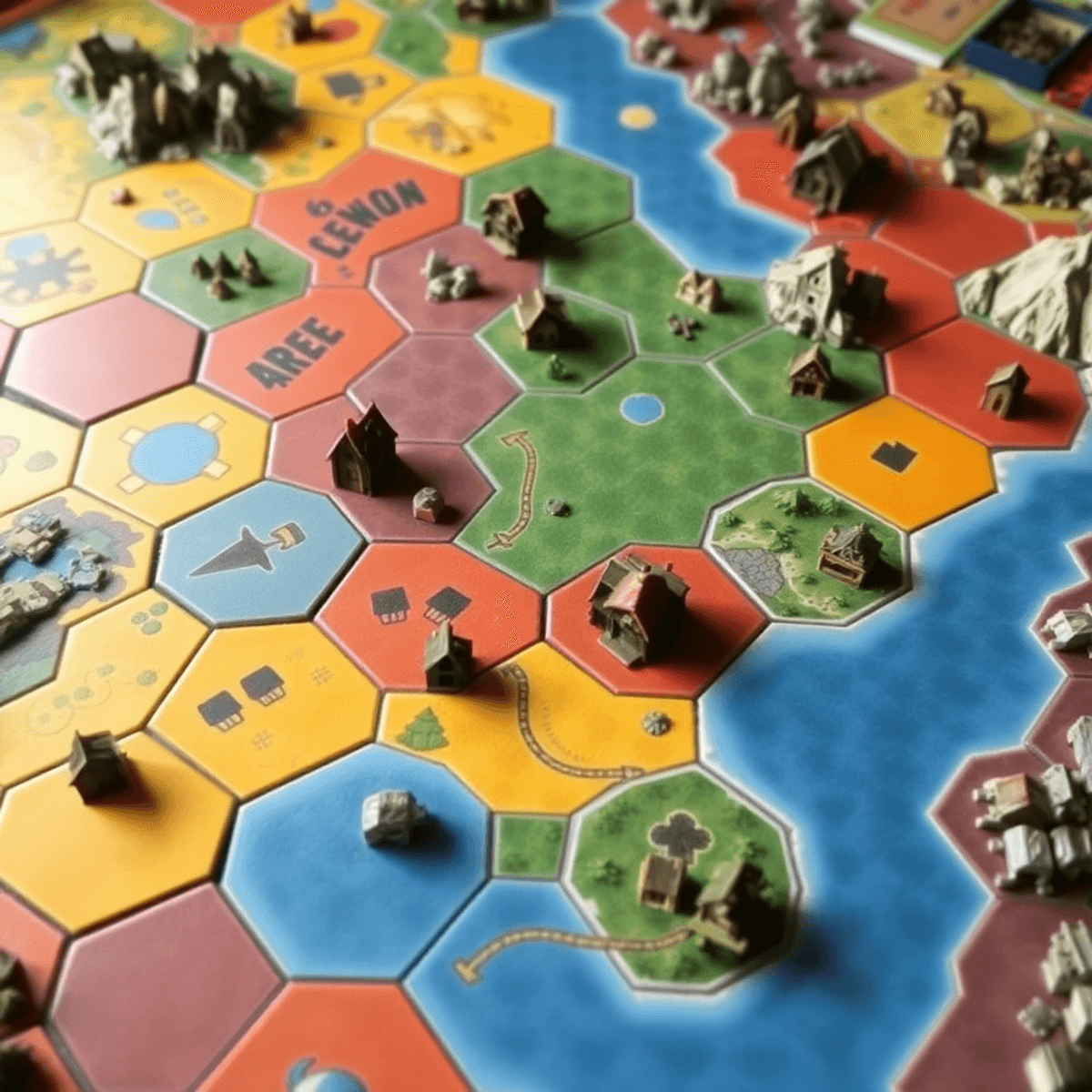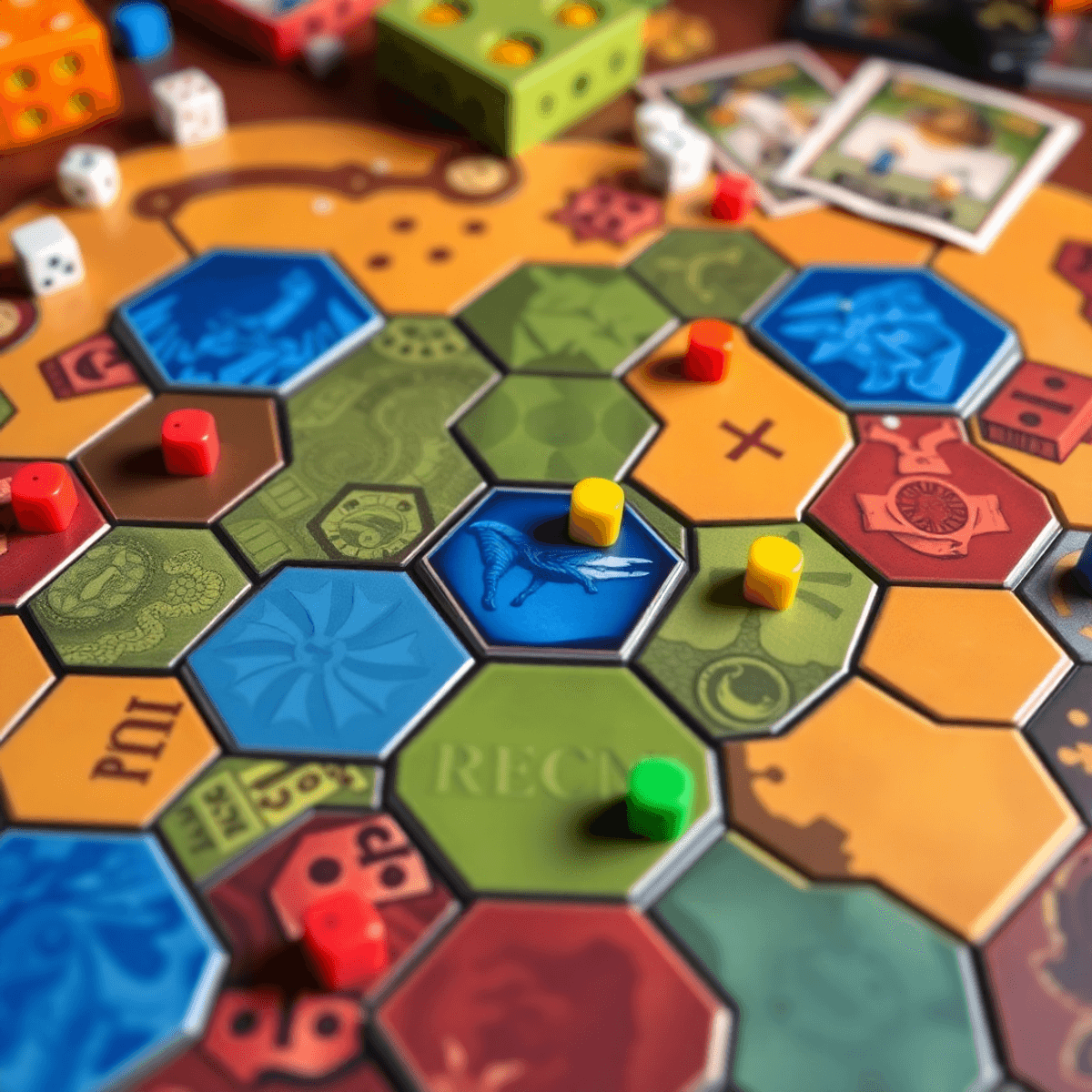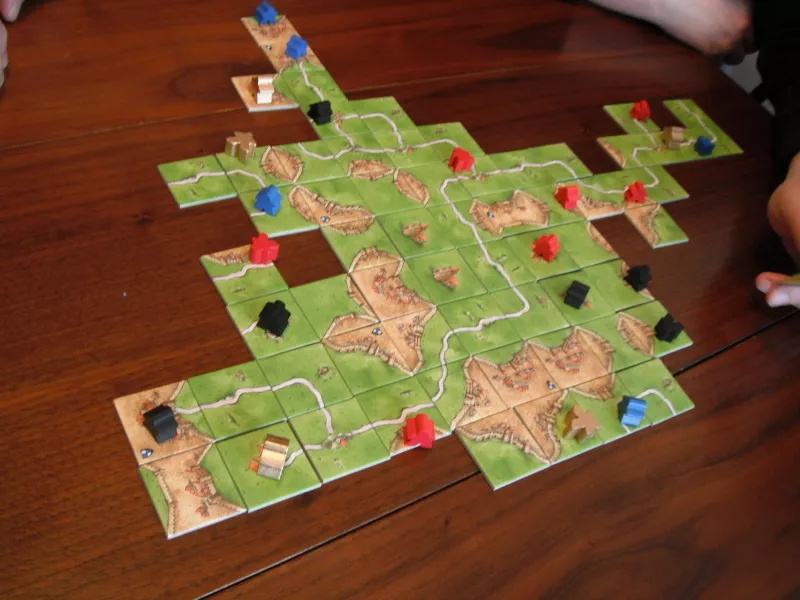
Board games are all about new and creative ways to play, with tile placement and modular game design being two of the most important features in today’s tabletop games. These mechanics turn fixed game boards into interactive playing fields where players shape their own paths by adding pieces strategically. Keep reading to learn everything about evolution of tile placement & modular game design.
When Carcassonne was released in 2000, it changed the game forever. It introduced a simple yet brilliant system that allowed players to create medieval landscapes by placing tiles in a clever manner. This innovative design not only transformed how games approached spatial thinking and control over territories but also set off a wave of new ideas in the industry.
Several other significant games have also made an impact on this genre:
- Tigris & Euphrates redefined civilization building through abstract tile placement
- Isle of Skye brought economic elements to territorial expansion
- Kingdomino simplified the mechanics for broader accessibility
- Suburbia elevated city-building through hex-based tile placement
These titles demonstrate the wide-ranging applications of modular design, catering to various player preferences from casual family-friendly experiences to intricate strategic puzzles. As the board gaming community continues to grow and evolve, designers are constantly seeking fresh approaches to push boundaries further, crafting immersive gameplay through thoughtful arrangement of cardboard components on the table.
The Evolution of Tile Placement Mechanics
Tile placement mechanics have their roots in the early days of board gaming. Games like Dominos set the stage for this strategic element. However, it was Reiner Knizia’s Tigris & Euphrates, released in 1991, that took things to the next level by introducing intricate civilization building through clever tile positioning.
Pre-2000 Tile Placement Games
Before 2000, tile placement games mainly focused on:
- Matching patterns
- Controlling territories
- Managing resources
- Creating paths
The Game-Changer: Carcassonne
The release of Carcassonne in 2000 brought about a major shift in tile placement game design. Designer Klaus-Jürgen Wrede reinvented the mechanic by introducing:
1. The Meeple System
- Small wooden figures that claim board features
- Multiple scoring opportunities throughout gameplay
- Dynamic player interaction through territory disputes
2. Innovative Scoring Mechanics
- Immediate points from completed features
- End-game scoring for incomplete structures
- Shared scoring possibilities through clever placement
The game’s elegant design struck a perfect balance between accessibility and strategic depth. Players could grasp the basic mechanics within minutes, yet mastering optimal tile and meeple placement required considerable skill.
The Ripple Effect: Innovation Inspired by Carcassonne
The success of Carcassonne triggered a wave of innovation in tile placement design. Other games started incorporating:
- Varied tile shapes
- Multiple placement rules
- Complex scoring conditions
This evolution paved the way for hybrid mechanics, where tile placement combined with other game systems to create more immersive gaming experiences.
Versatility of Tile Placement Mechanics
The flexibility of this mechanic allowed designers to replicate various themes such as:
- City building
- Agricultural development
As a result, tile placement has become a fundamental aspect of contemporary board game design.

Modular Boards: A New Dimension in Game Design
Modular board design represents a revolutionary shift in tabletop gaming, introducing dynamic playspaces that transform with each session. Unlike traditional fixed boards, modular systems consist of interchangeable components that create unique configurations, offering players fresh challenges and endless replayability.
Core Design Principles of Modular Boards:
- Variable setup possibilities
- Scalable difficulty levels
- Customizable game length
- Adaptable player counts
The success of modular design sparked a wave of innovation in contemporary board games. Isle of Skye exemplifies this evolution by combining auction mechanics with territory building. Players bid on tiles representing Scottish landscapes, creating unique kingdoms while adapting their strategies to ever-changing market conditions.
Kingdomino brought another breakthrough by streamlining modular mechanics for broader accessibility. Its domino-inspired tiles feature different terrain types, allowing players to construct kingdoms through simple yet strategic placement decisions. The game’s elegant design earned it the prestigious Spiel des Jahres award in 2017.
Notable Modular Design Innovations:
- Isle of Skye’s auction system
- Kingdomino’s domino-inspired mechanics
- Dynamic scoring conditions
- Interconnected tile relationships
Modern designers continue pushing boundaries by incorporating modular elements into various genres. Games like 7 Wonders Architects demonstrate how modular components can enhance both competitive and cooperative experiences, while titles such as Cascadia showcase the potential for environmental storytelling through modular terrain tiles.
The versatility of modular board design has sparked creative implementations across different complexity levels. From family-weight games to complex strategy titles, designers harness modular elements to craft engaging experiences that remain fresh through multiple playthroughs.
Exploring the Differences: Tile Placement vs. Modular Board Games
While often mentioned in the same breath, tile placement and modular board games represent distinct design approaches with unique characteristics. Let’s examine their key differences:
Tile Placement Games
- Players actively build the game board during play
- Each placement directly affects scoring opportunities
- Immediate tactical decisions impact game state
- Limited or no pre-game setup required
- Examples: Carcassonne, Kingdomino
Modular Board Games
- Board configuration set before gameplay begins
- Fixed layout throughout the game session
- Strategic planning based on known board state
- Variable setup creates replayability
- Examples: Settlers of Catan, Small World
Several games masterfully blend these approaches to create rich gaming experiences. 7 Wonders: Architects incorporates modular board elements while letting players build personal tableaus through tile placement. Eclipse: Second Dawn for the Galaxy uses modular sector tiles for exploration while maintaining a structured galaxy framework.
The hybrid approach adds depth through:
- Dynamic board evolution
- Strategic adaptation to changing layouts
- Multiple layers of decision-making
- Enhanced player interaction
Twilight Imperium exemplifies this fusion by combining modular sector setup with ongoing tile discoveries. Players must navigate both the initial board configuration and subsequent tile placements, creating a complex strategic environment where every decision carries weight in the expanding game space.
Recommended Tile Placement Board Games to Try
The board gaming community offers a rich selection of tile placement games that cater to different player preferences and skill levels. Here’s a curated list of must-try titles:
Classic Masterpieces
- Carcassonne – The quintessential tile placement game where players build medieval landscapes, claim territories, and score points through strategic meeple placement
- Tigris & Euphrates – Reiner Knizia’s masterwork combining tile laying with civilization building and complex scoring mechanisms
- Alhambra – A beautiful blend of tile placement and set collection where players construct palatial gardens
Modern Innovations
- Suburbia – A city-building game that introduces income and reputation mechanics alongside hex tile placement
- Barenpark – A lighter yet engaging experience where players construct their own bear sanctuary through polyomino tile placement
- Horseless Carriage – A deep economic simulation using innovative tile placement mechanics to represent technological advancement
Hidden Gems
- Nova Luna – An abstract tile placement game with unique time-track mechanics
- Copenhagen – Combines polyomino placement with card drafting in a visually striking package
- Isle of Cats – Features rescue missions through polyomino cat placement and card play
Each game brings unique twists to tile placement mechanics:
- Weight Range: Light (Carcassonne) to Heavy (Horseless Carriage)
- Player Count: Solo options (Suburbia) to large groups (Carcassonne)
- Game Length: Quick 30-minute sessions (Barenpark) to epic 2+ hour experiences (Tigris & Euphrates)
These titles showcase the versatility of tile placement mechanics across different themes and complexity levels, offering entry points for new players and depth for experienced gamers.
Designing Engaging Modular Board Games: Tips from Industry Experts
Successful modular board game design requires a delicate balance of creativity, player engagement, and mechanical cohesion. Industry veterans share key principles that shape compelling modular experiences:
Core Design Elements
- Create tiles that serve multiple purposes
- Design clear visual connections between components
- Ensure each module adds meaningful choices
- Balance randomness with strategic depth
- Test edge cases extensively
Game designer Alexander Pfister emphasizes the importance of spatial relationships in modular designs: “Each tile should create interesting decisions not just for the current turn, but for future possibilities.”
Strategic Integration Tips
- Start with a strong core mechanism
- Layer complementary systems gradually
- Maintain consistent rules across modules
- Design for replayability through varied configurations
- Consider player count scalability
“The best modular designs feel natural, not forced. Players should discover new combinations without being overwhelmed by complexity.” – Elizabeth Hargrave, Designer of Wingspan
Playtesting Considerations
- Verify module compatibility
- Test different player counts
- Assess game length variability
- Check for dominant strategies
- Evaluate learning curve
Veteran designer Uwe Rosenberg suggests focusing on interconnectivity: “Design modules that create meaningful relationships with adjacent pieces while maintaining individual value.”
The art of blending tile placement with modular design lies in creating systems where each placement decision ripples through multiple game aspects. Successful designers achieve this by establishing clear relationships between components while preserving player agency in strategic choices.
The Strategic Depth Offered by Tile Placement Mechanics
Tile placement mechanics create intricate decision spaces where each move ripples through the entire game state. Players must constantly evaluate multiple factors:
- Spatial Relationships – The positioning of tiles affects scoring opportunities, territory control, and resource access
- Timing Considerations – Deciding when to place specific tiles can create or block opportunities
- Resource Management – Balancing immediate gains against long-term strategic positioning
The beauty of tile placement lies in its ability to generate emergent gameplay through simple rules. In games like Tigris & Euphrates, a single tile placement can trigger complex chain reactions, forcing players to think several moves ahead.
Player Interaction in Tile Placement Games
Player interaction in tile placement games occurs through both direct and indirect means:
- Territory Control – Creating barriers or enclosing areas to limit opponent options
- Resource Competition – Racing to claim valuable board positions
- Tactical Interference – Disrupting opponents’ plans through strategic tile placement
Unique Strategic Landscapes
The modular nature of these games creates unique strategic landscapes each session. Players must adapt their strategies based on:
- Board configurations
- Available tiles
- Opponent positioning
- Scoring opportunities
Games like Suburbia demonstrate how tile placement can simulate complex systems through interconnected effects. Each tile affects adjacent pieces, creating a web of dependencies that rewards careful planning and tactical awareness.
This strategic depth emerges naturally from the core mechanics, as players navigate the tension between immediate tactical advantages and long-term strategic goals. The visible nature of tile placement also allows players to read their opponents’ strategies and respond accordingly, adding layers of psychological gameplay to the experience.
Conclusion: The Future of Tile Placement & Modular Game Design in Board Gaming Community
The world of board games is on the brink of exciting new developments in tile placement and modular design. With the integration of digital technology, traditional tile-laying mechanics are set to be enhanced through augmented reality experiences, giving rise to hybrid games that seamlessly combine physical and digital elements.
Game designers are actively exploring various avenues to push the boundaries of game design:
- AI-assisted design tools to create balanced and dynamic modular boards
- 3D-printed custom tiles for personalized gaming experiences
- Environmental themes that tackle climate change through tile placement mechanics
- Legacy elements that permanently modify game boards over multiple play sessions
The emergence of smart materials and interactive components suggests a future where tiles react to player actions, introducing new layers of strategic complexity. These technological advancements, coupled with the timeless appeal of physically manipulating game pieces, indicate a future where games retain the satisfying feel of tile placement while embracing modern gaming innovations.
The next wave of tile placement games will likely challenge conventions by incorporating:
- Real-time gameplay elements
- Cooperative mechanics
- Narrative-driven campaigns
- Social deduction aspects
This evolution guarantees that tile placement and modular design will continue to be vibrant and captivating mechanics within the board gaming community.




